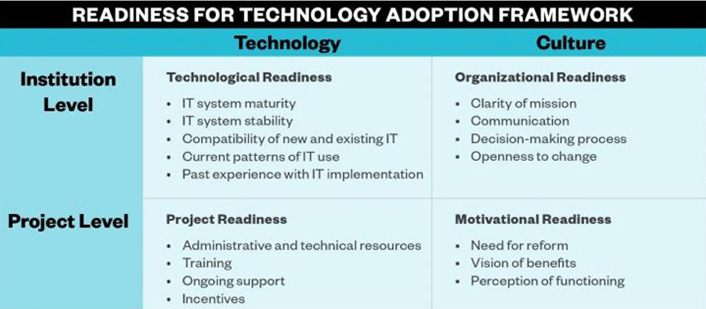Colleges and universities across the country are increasingly looking to technology to support significant reform to their academic, career, and financial advising services so they can provide a more integrated experience for their students as well as faculty and staff. This type of technology-mediated advising reform is known as Integrated Planning and Advising for Student Success (iPASS) [http://www.achievingthedream.org/iPASS]. Many higher education institutions are already implementing important components of iPASS, including degree planning and scheduling, risk intervention, and coaching. However, pursuing advising and planning reforms in a holistic and comprehensive way that leads to transformative institutional change rather than merely the adoption of new technology can be challenging.
The Community College Research Center (CCRC) defined transformative change as occurring at the nexus of structural, process, and attitudinal change. To successfully adopt technology and transform the advising and planning experience for students, institutions engaged in iPASS must pay attention to all three types of change. Utilizing CCRC’s Readiness for Technology Adoption (RTA) Framework and Self-Assessment, Achieving the Dream designed a survey tool and discussion process for iPASS grantees to facilitate and engage in an honest discussion about the institution’s preparedness for the work.

Source: Karp & Fletcher (2014)
The RTA Framework and Self-Assessment covers four areas of technology adoption as shown in the image: technological readiness, organizational readiness, project readiness, and motivational readiness. It helps institutions identify the elements they need to strengthen for successful implementation and adoption of the new tools. Each of Achieving the Dream’s 15 grantees used the tool to assess their readiness to implement their bold iPASS reforms.
After completing the pre-reading documents (CCRC’s Evaluating Your College's Readiness for Technology Adoption and Adopting New Technologies for Student Success: A Readiness Framework), they convened a broad range of cross-hierarchical and cross-functional stakeholders to contribute to the discussions. The size of the discussion teams ranged from 5–19 and included these representatives:
- 10 institutions had an IR representative on their team
- 14 institutions had an IT representative on their team
- 9 institutions had an advisor on their team
- 9 institutions had a faculty member on their team
- 2 institutions included the president on their team
Eight of the 15 colleges opted to distribute the RTA survey tool to team members prior to the discussion. This enabled them to submit their individual scores for their institution, which gave the team a starting point for their discussions in order to come up with one consensus score for the institution.
The discussions lasted from a few hours to a few days, depending on the institution. They all resulted, though, in one commonly agreed on score for each of the four components. According to the teams, the discussions were the greatest benefit of the RTA process. Participants reported anonymously that the RTA produced a dialogue that might not otherwise have happened:
- "This was a great exercise to have good dialogue from all levels of leadership and aspects of the college."
- "The mix of campus participants enriched the conversation."
- The RTA "allowed us to address misconceptions" and "identify areas we need to work on."
- "Affirmed the struggles the institution has with communication, which forced us to discuss a way forward."
- "Provided the opportunity we needed to begin the conversation on how we as a system should move forward."
- "There were significant changes in the scores for the technological readiness because the CIO was part of the IPASS team and discussed the extent of upgrades and initiatives that have taken place over the last 18 months."
- "Realizing where we need to improve as a group makes change more likely to happen."
- "Helpful to begin thinking about resources and support we need so we don’t ask for them too late."
- "It was extremely helpful to think about action items that will help frame the work as we go forward."
Conducting the RTA self-assessment is an important step in building an action plan because it encourages necessary conversations across the institution. It allows teams to identify additional steps that may need to take place before implementing an iPASS project and assist with evaluating indicators for transformative reform. Even if an institution has already begun some iPASS reform, conducting an RTA self-assessment will be an important step in successfully taking the project to the next stage.
In my next post, I will share how the grantees rated their readiness for iPASS adoption and specific recommendations for any college or university pursuing institution-wide reforms like iPASS.
Mei-Yen Ireland is Associate Director for Data and Technology for Student Success at Achieving the Dream and is the project lead for Achieving the Dream's initiative that provides strategic assistance to iPASS grantees. Follow her on Twitter @MeiYenIreland.
